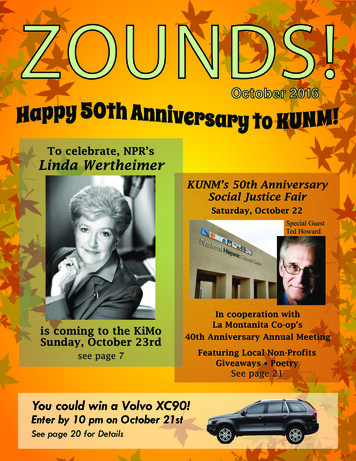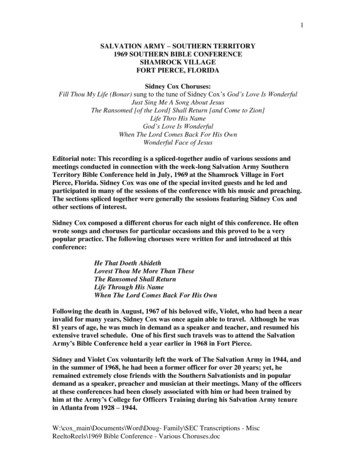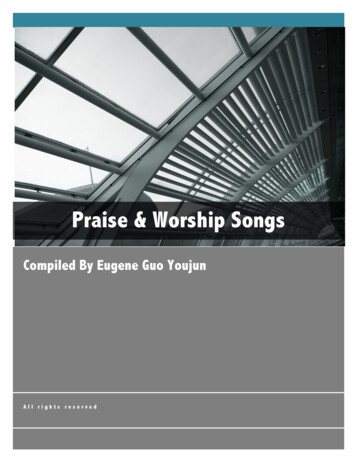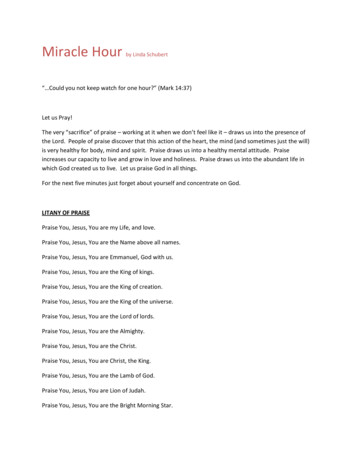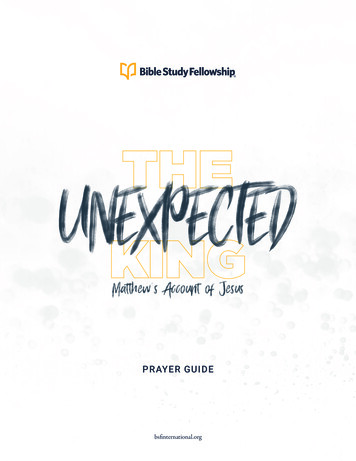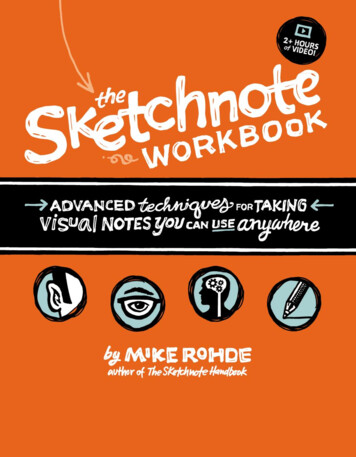
Transcription
PRAISE FOR THE SKETCHNOTE WORKBOOK“The practical lessons in The Sketchnote Workbook make it easy and funfor anyone to leverage visual note taking to help them remember more,communicate better, and develop ideas more completely.”— Todd Henry, author of Die Empty“If you want to succeed in capturing and communicating your ideas,you need to read this book. Because it’s not merely a book:It’s a blueprint for a new way of thinking, and it’s fantastically useful.”— Daniel Coyle, The New York Times best-selling author ofThe Talent Code and The Little Book of Talent“Mike has created a resource that will inspire anyone to take their doodling to a new leveland begin using sketchnoting in every aspect of their lives. After reading this book,I know my recipe cards and travel journals will never look the same again!”— C.C. Chapman, author of Amazing Things Will Happen“Mike Rohde wants you to understand a simple idea: Drawing aids thinking.Or, even better, drawing IS thinking. I fully agree with him: Pen and paper amplify ourthinking when we use them to record what we see, and to reflect on what it means.This book, as its predecessor, The Sketchnote Handbook, will not just makeyou a better artist, it’ll make you a better thinker.”— Alberto Cairo, author of The Functional Art“I present information as narrated visuals so Mike’s approach makes a lot of sense to me.Visuals are key to understanding complexity, and the combination of images and textas notes is always more effective than notes alone.Sometimes they are more effective than the original presentation.”— Horace Dediu, founder of Asymco“We humans are visual! So if you want to build your creativity and communication skillsin order to facilitate the most powerful business meetings and give genius presentations,then The Sketchnote Workbook is one of the most fun and effective ways I know to do it. ”— Mark Bowden, president of TRUTHPLANE Communication Trainingand author of Winning Body Language“Learning to capture the world in pictures and words changed my life, but it took me yearsof trial and error. How I wish I’d had Mike Rohde’s generous books as guides!”— Austin Kleon, author of The New York Times best-seller Steal Like an Artist
This page intentionally left blank
THE SKETCHNOTE WORKBOOKAdvanced techniques for taking visual notes you can use anywhereMike RohdePeachpit PressFind us on the Web at www.peachpit.comTo report errors, please send a note to errata@peachpit.comPeachpit Press is a division of Pearson Education.Copyright 2015 by Michael D. RohdeAcquisitions Editor: Nikki Echler McDonaldDevelopment Editor: Jan SeymourProduction Editor: Tracey CroomProofreader: Liz WelchIndexer: James MinkinCover Design and Illustrations: Mike RohdeInterior Design and Illustrations: Mike RohdeVideo Producer: Brian ArtkaMedia Producer: Eric GeoffroyNOTICE OF RIGHTSAll rights reserved. No part of this book may be reproduced or transmitted in any form byany means, electronic, mechanical, photocopying, recording, or otherwise, without the priorwritten permission of the publisher. For information on getting permission for reprints andexcerpts, contact permissions@peachpit.com.NOTICE OF LIABILITYThe information in this book is distributed on an “As Is” basis without warranty. While everyprecaution has been taken in the preparation of the book, neither the author nor Peachpit shallhave any liability to any person or entity with respect to any loss or damage caused or allegedto be caused directly or indirectly by the instructions contained in this book or by the computersoftware and hardware products described in it.TRADEMARKSMany of the designations used by manufacturers and sellers to distinguish their products areclaimed as trademarks. Where those designations appear in this book, and Peachpit was awareof a trademark claim, the designations appear as requested by the owner of the trademark. Allother product names and services identified throughout this book are used in editorial fashiononly and for the benefit of such companies with no intention of infringement of the trademark.TED talks referenced in sketchnotes throughout this book are copyright TED Conferences,LLC. No such use, or the use of any trade name, is intended to convey endorsement or otheraffiliation with this book.ISBN 13: 978-0-133-83171-9ISBN 10: 0-133-83171-X987654321Printed and bound in the United States of America
This book is dedicated to Gail, Nathan, Linnea, Landon,Mom, Dad, and all of my dear friends and community.I couldn’t have created this book without your support.We did it!
ACKNOWLEDGMENTSTHE SKETCHNOTE WORKBOOK WAS GOING GREAT, until it turned upside-downwith a family medical emergency halfway through its creation. Without a doubt,the supportive network and amazing editors and publisher kept this book you’rereading alive. My deepest thanks go to family, friends, colleagues, and thesketchnote community for supporting us when everything seemed against us.GAIL, you’re the reason I do the work I do. We’ve been through some painful,difficult days in this season of our lives, but we’re hanging in there. Thanks foryour consistent, amazing support of what I love to do. I love you!NATHAN, LINNEA, AND LANDON, thanks for your support as I worked on asecond book project. My wish for you is that the work I’m doing makes you veryproud and that you love telling people your daddy wrote some pretty cool books.NIKKI MCDONALD, thanks for being my biggest fan and sticking with me, believingin me, and working so hard to make this second book come to life. In spite of allthe challenges we’ve faced together, you’ve been steady. I’m so proud of havingworked with you to create two amazing books that are like nothing else.JAN SEYMOUR, I’ve had a blast having you as my editor. You’ve embraced mybook from the start and together we’ve made this book even better than TheSketchnote Handbook. Thanks for cheering me on when things seemed darkest.PEACHPIT, your team was my secret weapon, once again. Thank you, Liz Welchfor your eagle eye, James Minkin for another perfect index, Tracey Croomfor making this a superb-looking book, and Eric Geoffroy for providing expertknowledge to create another fantastic video.DAVID FUGATE, I appreciate your guidance as my agent through another bookproject. Thanks for answering every crazy question I come up with.BRIAN ARTKA, thanks for telling my story with video and for being a great friend.You are always willing to push me to do my best and achieve excellence. I wouldn’twant to tell a story through video with anyone else.vi
DELVE WITHRINGTON, years ago we created The Sketchnote Typeface and now Ihave a second book set in it . Thanks for making book production so much easier forme and for making foreign translations much more likely.GABE WOLLENBURG, thanks for your sense of humor and your immediatewillingness to create another fabulous screenplay for my video. You rock!STEPHEN MORK, thanks for creating a fun, encouraging, and danceablesoundtrack. Your music adds a perfect positive vibe to the video.ERIC RESCH, JOE SORGE, MARK FAIRBANKS, CYNTHIA THOMAS, JON MUELLER,TOM & KATE GOMOLL, AND CYNTHIA LEVAN, thanks for letting us use your spacesin the Workbook video to show viewers that Milwaukee is a cool place to be.FEATURED SKETCHNOTERS: Don Pollitt, Jackie Pomeroy-Tso, Julie Stitt, MauroToselli, Chris Spalton, Sam “Pub” Smith, and Doug Neill, thanks for sharing yoursketchnoting journeys and experiences—not to mention your work.FRIENDS AND COLLEAGUES, thanks for your reviews and feedback about the bookand video as I created it. This is a better book because of your help.TO THE SKETCHNOTING COMMUNITY, this book is for you. Thanks for your strongsupport and encouragement along with sketchnote contributions as I labored tocreate this book. I can’t wait to see how you’ll use and improve these new ideas!vii
This page intentionally left blank
ABOUT THE AUTHORMIKE ROHDE has a passion for simple and usabledesign solutions. That passion, along with his lifelonghabit of recording concepts and observationsthrough sketching and doodling, inspired him todevelop sketchnotes—a practical art that translatessimple and complex ideas into easily recalled bitsof information.Professionally, Mike focuses on user interface,user experience, visual design, and icon design for mobile and web applicationsat Gomoll Research Design in Milwaukee, Wisconsin.Mike’s popular first book, The Sketchnote Handbook, convinces people aroundthe world to become sketchnoters every day. Translated into German, Russian,Chinese, and Czech, it guides readers in using their natural visual capabilities tocreate sketchnotes for better understanding, and to have fun taking notes.He enjoys speaking publicly about his passion for sketchnoting, sketching, andvisual thinking skills at venues across the United States.In his illustration practice, Mike uses his unique drawing style to amplify andclarify ideas. His work is featured in REWORK and REMOTE, two best-sellingbooks by Jason Fried and David Heinemeier Hansson; The 100 Startup, a bestselling book by Chris Guillebeau; and The Little Book of Talent by Daniel Coyle.Community and sharing are important cornerstones of Mike’s philosophy, asevidenced by the creation of The Sketchnote Army, a website dedicated tofinding and showcasing sketchnotes and sketchnoters from around the world.Mike has also shared his thinking, design process, and samples of his design andillustration work at his personal website, rohdesign.com, since 2003.Mike lives with his wife, Gail, and children, Nathan, Linnea, and Landon, justoutside of Milwaukee. He’s an avid Green Bay Packers fan.Learn more about Mike at rohdesign.com.ix
CONTENTS
INTRODUCTIONA YEAR AND A HALF AGO, THE SKETCHNOTE HANDBOOK WASRELEASED INTO THE WORLD. Frankly, I was nervous about the launch. Ihad no idea how my first book would be received.Boy, was I wrong to worry! The Sketchnote Handbook launched to immediateexcitement from its readers. I received a constant stream of positive social mediamentions, encouraging email messages, and more positive book reviews than Iwould have imagined. It was an awesome experience.Invitations to appear on podcasts came in while reviews were posted on blogs andwebsites. Within a few months, Peachpit Press had to print more copies of theHandbook video edition due to brisk sales.German and Russian publishers licensed and printed Handbook translations,which became hits in those countries, while Czech and Chinese publisherslicensed the book for their own native versions of the Handbook.I spoke on sketchnoting in Portland, Austin, San Antonio, and Chicago, selling out ofthe books I’d brought with me. I was stoked when Moleskine reached out to create alimited-edition custom sketchbook to give away at SXSW in Austin.All I could think was, “Wow, this book is a hit!” And I still receive positive feedbackfrom people all over the world.Why such positivity? Business owners, consultants, designers, developers,writers, doctors, teachers, students, and parents all tell me how my SketchnoteHandbook has changed their mindset. For many, the book has encouraged themto more deeply engage in and understand the ideas they’re seeing and hearing.People tell me that sketchnoting has given them the freedom and flexibility toplay with ideas, enabling them to create meaningful visual documents that helpthem better understand and remember ideas and experiences.xii
The constant flow of positive feedback, blended with my desire to share moreways to apply sketchnotes, inspired me to write The Sketchnote Workbook.WHAT IS THE SKETCHNOTE WORKBOOK?Capturing meeting notes or sessions at conferences is a great way for readers toimmediately apply sketchnoting techniques and see great value in the approach.The hundreds of sketchnotes I’ve seen since the release of the Handbook verify it.But there are still many more ways sketchnotes can be used that I want to share.As a veteran designer, I use sketchnotes for idea generation and idea mappingdaily. For years I’ve created travel and food sketchnotes that transport me backto memorable experiences.My food sketchnotes fromPortland, Oregonxiii
But it’s not just me. Friends in the sketchnoting community constantly share howthey use sketchnotes to document processes, plan projects, and capture ideas inbooks, movies, TV shows, and sporting events.I’ve collected the techniques I’ve learned from fellow sketchnoters in thecommunity, waiting for the right time and place to share them. You’ll find thisworkbook full of new sketchnoting ideas, plenty of worksheets, and a range ofchallenges designed to rapidly improve your sketchnoting skills.My hope is that by working through this book, you’ll be inspired to try newsketchnoting ideas. I’d love to see you adopt advanced drawing techniques to tacklethe tougher sketchnoting challenges you’ve been avoiding—until now.ter 6Workbook - ChapThe Sketchnotexiv
HOW TO USE THIS BOOKI’ve created this book and video to be enjoyed in one go, or used as a reference youcan jump around in. If an idea grabs you, try it out! Experiment until it fits yourway of working.The ideas in this book are here for you to iterate on and improve. Worksheets andchallenges in the book aren’t rigid or designed to have just one correct answer.Rather, this book and its exercises should be seen as experiments and notassignments. Have fun playing and exploring!JOIN THE COMMUNITYAs you explore ideas in this book, share your work with the sketchnotingcommunity. We’re welcoming and encouraging to everyone. Start at TheSketchnote Handbook Flickr group, flickr.com/groups/thesketchnotehandbookand then stop by The Sketchnote Army, SketchnoteArmy.com.You’ll see the work of many others that will inspire and challenge you. I lookforward to you joining the discussion!REACH OUTPlease reach out and say hello. Check out my sketchnotes, read my writing, andsign up for my free newsletter at rohdesign.com. I’m a very active Twitter user, soreach out at twitter.com/rohdesign.I look forward to hearing how you apply ideas in the Workbook and seeing whatnew ideas you come up with for using sketchnotes in your own life.ALL RIGHT, ENOUGH TALK—IT’S TIME FOR ACTION.GRAB A NOTEBOOK AND A PEN.LET’S SKETCHNOTE!xv
132
133
134
135
136
137
138
139
142
143
INDEX3D lettering, 188–189condensed lettering, 186, 187Aconnecting ideas, 47about this book, xiii–xvcontainers, 13Agerbeck, Brandy, 190Cox, Ruud, 151agile planning, 84–87Crofts, A. V., 134Alderman, Jason, 138, 191audio, sketchnoting, 158–160DDaniels, C. Wess, 50BDave Gray Method, 9, 191Bennett, Jeff, 102diagrams, 13, 72Berman, Craighton, 16documenting with sketchnotes, 92–111Bildesheim, Oliver, 118benefits of, 95blank page paralysis, 17challenge tasks for, 103Bonnema, Laurens, 67, 86communicating ideas, 106–107books, sketchnoting, 161–163creating process documents, 96–100Boudwin, Marichiel, 102, 127featured sketchnoter on, 108–109bullets in sketchnotes, 13how-to documents, 104–105businessicons used for, 110icons related to, 33recap of main points on, 111travel sketchnotes for, 120, 122recipes, 102, 103, 108–109step-by-step instructions, 101–103Cdoodling, 174caching ideas, 170drawingCasabona, Joseph, 154faces, 9, 192–194Century Schoolbook typeface, 181five elements of, 8Cerantola, Claudia, 52people, 9, 191Chew, Boon Yew, 134type, 10, 12, 180–190Chua, Sacha, 74, 162Clarke, Todd, 19, 163EClayton, Michael, 153, 208education-related icons, 31collaboration, 106email, sharing via, 179communicating ideas, 106–107202computer-based fixes, 175
Erb, Veronica, 23Gray, Dave, Method, 9, 191Esch, Jessica, 138, 179grid format, 17, 18–19, 24, 27Esser, Thiago, 51Guintu, Dante, 94Eurostile Extended typeface, 187extended lettering, 186, 187HHagan, Margaret, 106Fhead shapes, 192faces, drawing, 9, 192–194Henriquez, Jay, 21five-year plan, 76–77Hey, Jono, 104fixing mistakes, 175Holgate, Claire, 93flash cards, 57–59how-to documents, 104–105Flickr group for book, xvhumor, 195Flores, Marem, 78font websites, 177Ifood sketchnotes, 132–143icons, 12, 28–33benefits of, 135documentation-related, 110challenge tasks for, 139food-related, 142creation process for, 136–137idea generation, 28, 30featured sketchnoter on, 140–141industry-specific, 30, 31–33group creation of, 138language learning using, 60–61icons used for, 142library of, 30, 36, 60–61, 197–199recap of main points on, 143media-related, 166freeform format, 17, 22–23, 26project planning, 90Futura Shaded typeface, 189quality levels for, 30future planning, 74–77reference book for, 36task management, 70Gtravel-related, 78, 82, 130generating ideas. See idea generationGoogle Images, 177worksheets for creating, 31–33idea generation, 14–37Graham, Derek, 55challenge tasks for, 27Graphic Facilitator’s Guide, Thedescription of, 15(Agerbeck), 190featured sketchnoter on, 34–35freeform format for, 17, 22–23, 26203
grid format for, 17, 18–19, 24, 27icons used for, 28–33, 36power of sketchnoting for, 16problem solving through, 34radial format for, 17, 20–21, 25, 27recap of main points on, 37timeboxing and, 15worksheets for, 24–26idea mapping, 38–65benefits of, 41challenge tasks for, 49, 53, 56, 59JJocham, Hubert, 185KKleon, Austin, 9, 146, 159Koekemoer, Mark, 156Kücklich, Julian, 157Llanguage learning, 57–61flash cards for, 57–59creation process for, 42–48description of, 39–40featured sketchnoter on, 62–63flash cards for, 57–59icon library for, 60–61language learning with, 57–61icon library for, 60–61law-related icons, 32LeFrank, Deborah, 114letter writing, 52–53lettering techniques, 10, 180–1903D type, 188–189presentations based on, 54–56condensed type, 186, 187recap of main points on, 65extended type, 186, 187tools used in practice of, 64script type, 184–185writing based on, 50–53, 62–63serif type, 180–181ideasslab serif type, 182–183communicating, 106–107connecting, 47exploring, 16generating, 14–37mapping, 38–65numbering, 17repetition of, 171resonating with, 6staking out, 170image resources, 177index cards, 64industry-specific icons, 30, 31–33Internet resources, 177204speed and quality of, 190Lewis, Makayla, 117library of icons, 30, 36, 60–61, 197–199Lim, Winnie, 101linear sketchnote pattern, 11Mmapping ideas. See idea mappingMartinez, Heather, 93, 138media-based sketchnotes, 144–167audio and, 158–160benefits of, 147books and, 161–163
challenge tasks for, 152, 155, 160patternscreation process for, 148–150noting on idea maps, 48featured sketchnoter on, 164–165used for sketchnoting, 11icons used for, 166people, drawing, 9, 191informational videos and, 156–157personal travel sketchnotes, 117–119movies and, 151–152personas, sketchnoting, 85music and, 158–160photographsrecap of main points on, 167travel plan, 79sporting events and, 154, 155travel sketchnote, 121TV shows and, 153, 155planning with sketchnotes, 66–91messy sketchnotes, 42benefits of, 69metaphorschallenge tasks for, 73, 76, 81challenge task on, 196featured sketchnoter on, 88–89keys to creating, 195flexibility of, 68worksheet for, 196future planning, 74–77mistakes, dealing with, 175–176icons used for, 90modular sketchnote pattern, 11project planning, 83–87Möhlmann, Thorsten, 154recap of main points on, 91movie sketchnotes, 151–152task list creation, 70–73music sketchnotes, 158–160Myriad Condensed typeface, 187Ntravel planning, 78–82podcasts, sketchnoting, 158Pollitt, Don, 34–35Pomeroy-Tso, Jackie, 62–63Neill, Doug, 164–165popcorn sketchnote pattern, 11nooks on pages, 174Poznanski, Aga and Piotr, 58Norris, Ben, 117, 121presentationsNotes Plus, 4numbering ideas, 17OOkur, Aclan, 83Pidea maps for, 54–56sharing sketchnotes from, 178–179problem solving, 34process documentation, 96–100progress vs. perfection, 42project planning, 83–87agile scrum, 84, 86Palmer, Jake, 93, 94icons used in, 90path sketchnote pattern, 11personas used in, 85retrospective process, 87205
Ridea generation with, 14–37idea mapping with, 38–65radial format, 17, 20–21, 25, 27media, 144–167radial sketchnote pattern, 11pasting items in, 118recipes, 102, 103, 108–109patterns used for, 11reference sources, 177planning with, 66–91repetition of ideas, 171sharing, 178–179research gathering, 43reserved spaces, 172resonating with ideas, 6restaurant meals, 139retrospective, 87Rhone, Patrick, 208Rockwell typeface, 183rohdesign.com website, xvRowland, Francis, 127travel, 112–131sketchplanations, 104skill building path, 169skyscraper sketchnote pattern, 11slab serif lettering, 182–183smartphones, 176Smith, Sam “Pub,” 140–141social media, 178spacesSdoodling in nooks and, 174script lettering, 184–185scrum methodology, 84–87serif lettering, 180–181Seymus, Ivan, 75, 208shapescovering errors with, 175drawing for heads, 192sharing sketchnotes, 178–179Shipton, Chris, 157signatures, 13sketchbook for travel, 116Sketchnote Army website, xvSketchnote Handbook, The (Rohde), xii, 3, 191sketchnotesdefinition of, 4documenting with, 92–111elements of, 12food, 132–143206reserving for information, 172Spalton, Chris, 128–129Sparks, David, 71speech bubbles, 13sporting events, 154, 155sprint planning, 84, 86staking out ideas, 170Star Method, 9, 191step-by-step instructions, 101–103sticky notes, 64Stitt, Julie, 88–89Sultan, Umm, 172Susa Light typeface, 185Ttask lists, 70–73diagrams added to, 72icons used on, 70
tasting experiences, 139thought bubbles, 13Tiffin, Skyler, 40timeboxing, 15title pages, 173topic headlines, 45Torrance, Scott, 145Toselli, Mauro, 103, 105, 108–109travel sketchnotes, 112–131benefits of, 115business, 120, 122challenge tasks for, 119, 122featured sketchnoter on, 128–129icons used for, 78, 82, 130leaving space for, 125WWalker, Melinda, 161website of author, xvwhiteboards, 106, 107Wiatr, Guillaume, 19Wilkins, Amy, 23worksheetsicon creation, 31–33idea generation, 24–26metaphor, 196writer’s block, 41, 50, 62writingidea maps for, 50–53, 62–63sketchnote letters, 52–53pasting items in, 118personal, 117–119planning trips using, 78–82recap of main points on, 131sketchbook and pen for, 116steps for creating, 123–125taking photos of, 121TV-based sketchnotes, 153–155Twitter info for author, xvtypography, 12lettering techniques, 10, 180–190typeface collections, 177Vvan Mossevelde, Tyra, 127Vartabedian, Bryan, Dr., 107vertical sketchnote pattern, 11Vestergaard, Mathias, 21videos, sketchnoting, 156–157visual maps, 5, 16207
the books I’d brought with me. I was stoked when Moleskine reached out to create a limited-edition custom sketchbook to give away at SXSW in Austin. All I could think was, “Wow, this book is a hit!” And I still receive positive feedback from people all over the world. Why such positiv
